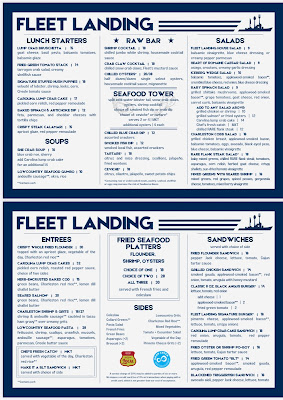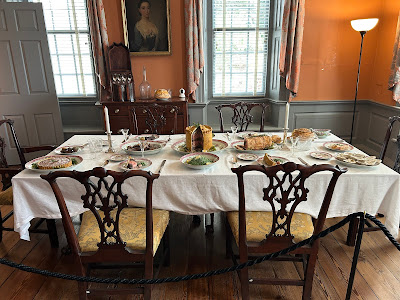I only saw brief portions of the movie called
Into the Woods. However, anything with Johnny Depp in it is definitely going to have unmistakable weirdness weaved into the characters. So, going into the James F. Dean Theater to see Steven Sondheim's adaptation, I was totally unaware what to expect in the way of a storyline. The live stage production is loosely inspired by the Grimm Brothers' fairy tales including
Little Red Riding Hood,
Jack and the Beanstalk,
Cinderella, and
Rapunzel with a witch thrown in to conjure up a little chaos for an unfortunate baker and his wife who want a child. They can undo their bad luck by collecting four objects in three days: the cow as white as milk, the cape as red as blood, the hair as yellow as corn, and the slipper as pure as gold.
The Flowertown Player's presentation of Into the Woods was an empty your bladder and settle into your comfy seat for a three-hour giant rompem' stompem' whopper of a tall tale, including the short intermission. As the play's red-caped little vixen (Mackenzie Comer) skipped between the trees from scene to scene, I inexplicably thought of the lyrics of the song of the same name by Sam the Sham and the Pharaohs, and it was surely looking good. The performance was everything a big bad review could want. So, listen to me.

The stage was set. The props were in place. The production team was intensely focused. Director Nina Kahn had her well prepared cast of 24 ready to hit the lights and hit the heights to kick off their three weekend "bag of magic beans". The musical performers were harmonious as a whole from the opening prologue to the closing finale, when they symbolically blew the roof off the theater. If there were any glitches in prop placement as they moved from scene to scene, I didn't see it. If there were any hick-ups in the casts dialogue as they moved from musical number to musical number, I did not detect any. However, I respectfully have to mention one tiny thing. I sat in row L, which was more than halfway back in the theater. I had to strain a little to hear some of the dialogue due to the music being a tad to dominant when the vocals were in less dynamic ranges, or maybe my hearing isn't what it used to be. I'll leave it to you to decide.
It was not so hard to hear one of the most entertaining singing collaborations of the play between Jonathan Ford and Elisha Black as Cinderella's prince and Rapunzel's prince, when they belted out "Agony" in confidence and stunning harmony. Along the line of upper decibels, there was no escaping the ear popping screams of "hair as yellow as corn" Rapunzel played by Rachel Hiester-Myers.
Other notable renditions were "Witch's Lament" sang by Sarah Daniel, "Moments in the Woods" performed by Liz Perez (the Baker's wife), who also teamed up with Justin Robinson (the Baker) in "It takes Two", "On the Steps of the Palace" executed by Meredith Lane (Cinderella) and singing "I Know Things Now" was Mackenzie Comer (Little Red).
Other cast notables were Bryce Beasley as bad boy giant-killer Jack, beside herself Rachyl Kissling as Jack's Mom, the well-dressed ravenous Wolf played by Zachary Henderson, Vance White II as the Narrator, long-time Flowertown Player Jamie Young, who did double duty as Mysterious Man and Cinderella's Father, Holly Matthew's as Cinderella's Stepmother, Angela Pinkham as Florinda, Julia Sorenson as Lucinda, Krissi Hardy as Cinderella's mother, Graycen Szalwinski as The Steward, and Leighton Winters (Sleeping Beauty), Maddie McCall (Snow White), Zach Rettig (Granny), Susie Hallat (Voice of the Giant), Patti MooPone (Milky White).
Finally, I must give special props to Julie Crist for her adept handling of one of the play's more challenging characters, "the cow as white as milk"--Milky White Puppeteer.
This musical fairy tale is unlike anything you have ever seen before. There is no yellow brick road that takes you to an Emerald City, but the witch is witchier, and who honestly said of herself, "I'm not good, I'm not nice, I'm just right. I'm the witch." And cute, bratty Little Red noted of the baker and his vow breaking wife, "You seem to argue a lot." Cinderella's not so pure, self-adoring prince confessed, "I was raised to be charming, not sincere." I could go on and on, but I will leave the rest for you to see and hear for yourself.
I encourage you to purchase a ticket, slip on your shoes, and make your way to the little theater on Hutchinson Square to see one of the funniest scenes of the play that has to do with guess what, footwear, and gold ones at that.
The cast skillfully delivers plenty of laughs along their way Into the Woods where you will discover family life isn't always little blue birds chirping happy bird songs, but it can also be downright morally and ethically jaded at times. Nevertheless, there is a happy ending in there somewhere.
Dates: March 7 - 23
Times: Evenings at 7:30 pm, Sundays at 3:00 pm
Tickets for Into the Woods
Photographs by Flowertown Players























































